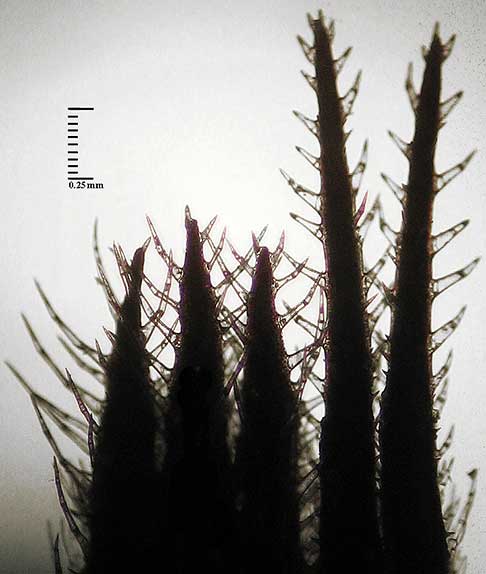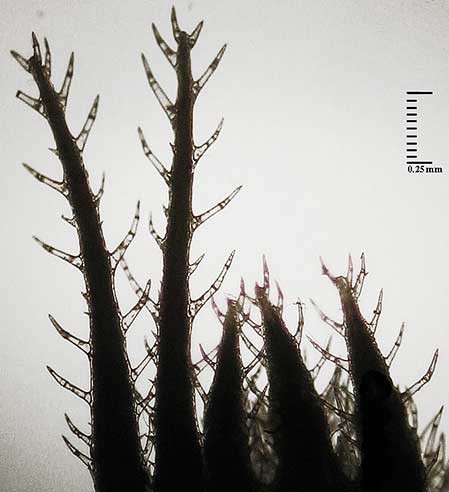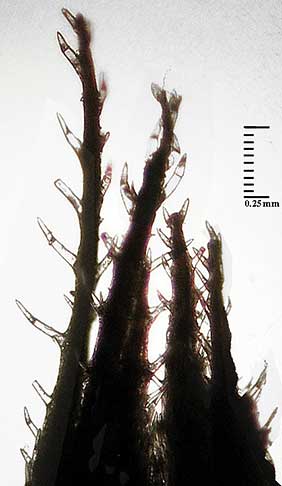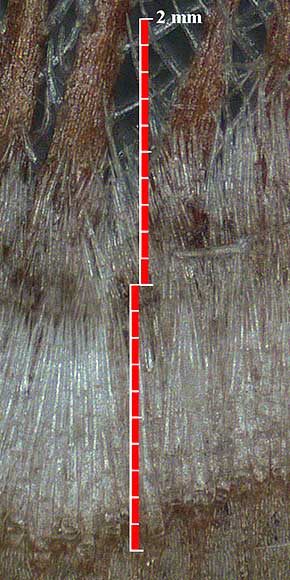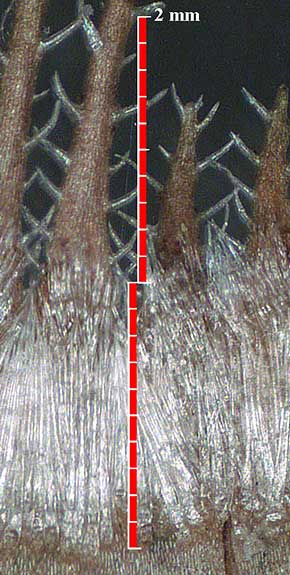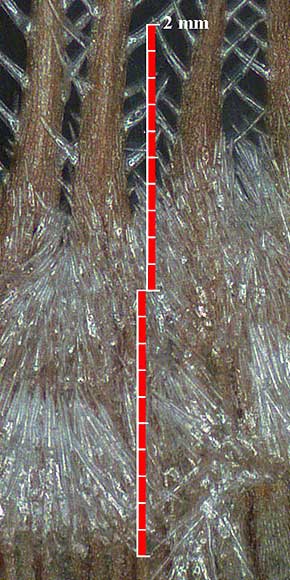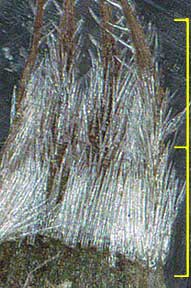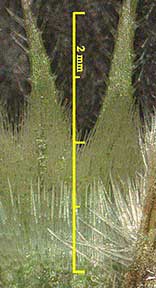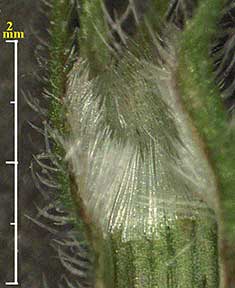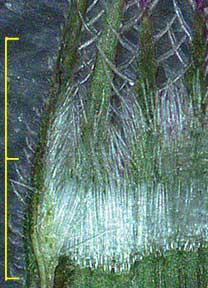
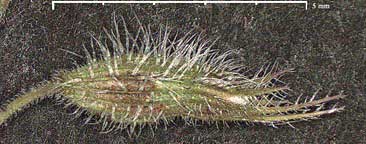

From top: H. reverchonii var. reverchonii (H.r.r.), H. r. var. serpyllifolia (H.r.s.), H. drummondii (H.d.) [click for enlarged view]
Calyx Features in the Hedeoma drummondii Complex
by Bob Harms

The calyx in the Hedeoma drummondii complex presents a highly complex morphology with numerous features with potential to distinguish its three taxa: H. reverchonii var. reverchonii (H.r.r.), H. r. var. serpyllifolia (H.r.s.), H. drummondii (H.d.).
Calyx Differentiae Listed by Robert Irving
In his 1968 dissertation Irving lists six calyx characteristics (Table 12, p. 261; said to present "the salient features which distinguish the varieties of H. drummondii," p. 260.) These are in addition to distinctive calyx teeth orientation used as key features (pp. 260-262).
| H. drummondii | H. reverchonii
var. reverchonii | H. reverchonii
var. serpyllifolia |
| Calyx length1 | 5.0-6.0 mm | 6.0-8.0 mm | 5.0-6.0 mm |
| Calyx pubescence2 | sparce | hoary | moderate |
| Calyx hair length3 | 0.5 or less | 0.75-1.5 mm | ca 0.5-0.75 mm |
| Upper teeth length4 | 1.0-1.5 mm | ca 1.0 mm | 1.0-1.2 mm |
| Lower teeth length4 | 1.5-2.0 mm | ca 1.5 mm | ca 1.5 mm |
| Annullus width5 | 1.0-1.5 | ca 1.5 mm | ca 1.5 mm |
1Of these, calyx length is the only clear differentia, distinguishing only
H.r.r.. I assume Irving's measurement includes both tube and teeth, for a total length.
2I find Irving's description too vague to permit application. I have found no significant difference in trichome quality or overall density. Compare the images below, especially those taken with a compound microscope at 40x.
3Hair length is highly variable along the calyx tube, as can be seen below. Irving does not specify how he measured this (longest hairs?, hairs at the tube midpoint?; hairs on the teeth were obviously not included). Overall
H.d. has the shortest hairs, but only if spring and summer plants are compared — and even then its lower calyx hairs commonly exceed 0.5 mm.
H.r.s.,
with fall season morphology, has even shorter hairs, with longest hairs commonly < 0.5mm.
4Teeth length measurements, especially for lower teeth, do not correspond to my observations, shown in the table below. Although overall
H.r.r. has the longest teeth there is enough overlap to rule this out as a useful differentia. (
Images for maximum lower teeth lengths.)
| | H.d. | H.r.s. | H.r.r. |
| average: | 1.8 mm | 1.9 mm | 2.5 mm |
| range | 1.5-2 mm | 1.75-2.1 mm | 1.6-3 mm |
5Annulus length measurements do not correspond to my observations, with little difference between
H.d./
H.r.r., both ca. 1.5 mm. But a structural difference in the annulus bands does distinguish these two from the somewhat shorter
H.r.s. — see the
discussion and images below.
(1) The 5 teeth
The calyx tube terminates in 5 teeth, 3 upper, narrowly triangular, and 2 lower, longer and subulate.
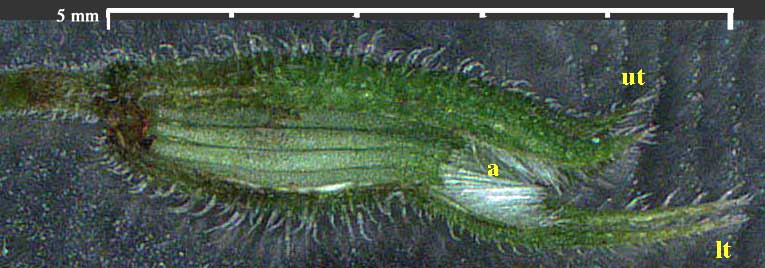
H. r. s., cut open to reveal the annulus trichomes (= a); ut: upper teeth; lt: lower teeth.

H. r. r.; ut: upper teeth; lt: lower teeth.
As noted by Irving the orientation of these teeth is distinctive, although it may not be apparent from all angles (sometimes difficult with mounted specimens):
- H. r. r.:
- the upper teeth are strongly recurved, spreading away from the lower teeth.
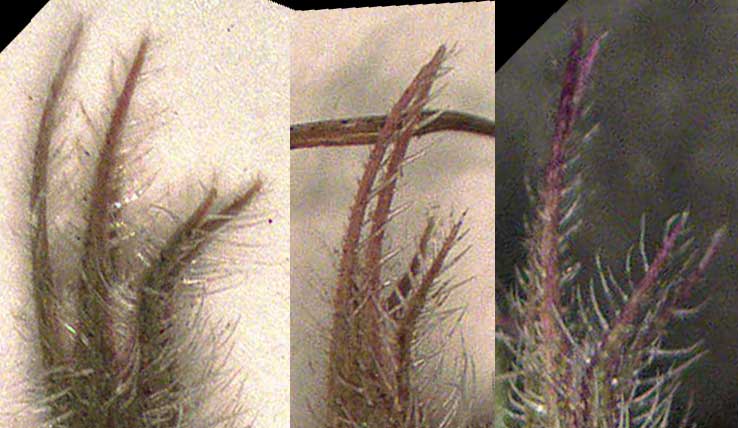
- H. r. s.:
- the upper teeth are recurved, and do not approach the lower teeth.
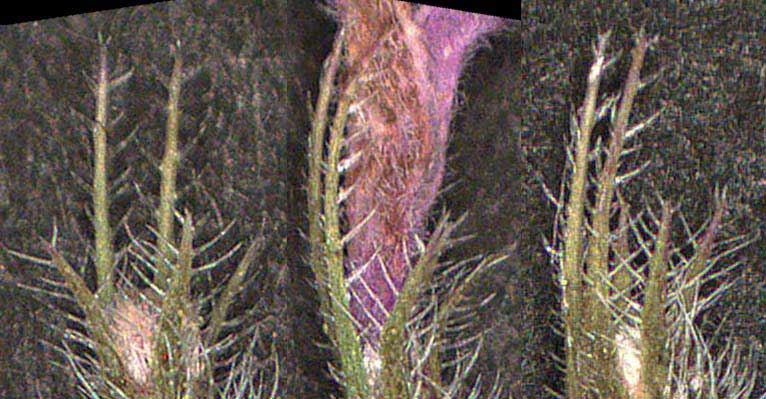
- H. d.:
- the upper teeth typically curve toward the lower teeth, at anthesis pressing against the corolla tube.
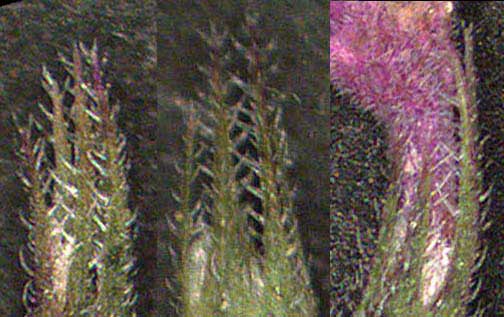
(2) Hair patterns on the tube
Trichomes on the tube are highly variable in size, distribution and orientation. Further, there may be a general asymmetry around the sides of the tube – note the upper and lower surfaces in the full calyx images above. Hairs not against the dark background are not in focus (depth of field) and aren't visible. [For early spring calyx hair differences.]
Trichomes of the pedicel are sharply retrorse, similar to those of the stem, and those of the calyx base are slightly larger and also curve downward. Above the calyx base the surface is densely populated at all stages of maturity with hairs of all sizes, from ca. 0.03 mm to greater than 1 mm.
The tiny hairs are not mentioned in the literature, which only seems to consider the longer hairs, which increase in length above the base.

Center calyx tube trichomes of H.r.s. photographed at 40x.

Upper calyx tube trichomes of H.r.r., dissected, 40x.
With all three taxa the typical orientation pattern is for hairs to gently curve downward at the base, becoming more spreading in the middle and curve upward above the middle. The above photo of H.r.s. was thus from roughly the center of the tube; of H.r.r., from the top.
The pattern of hair length on the tube between the base and the teeth is distinctive. Three patterns are typical when only the surface with the longest hairs is considered. And seasonally shorter calyx hairs follow this same pattern.
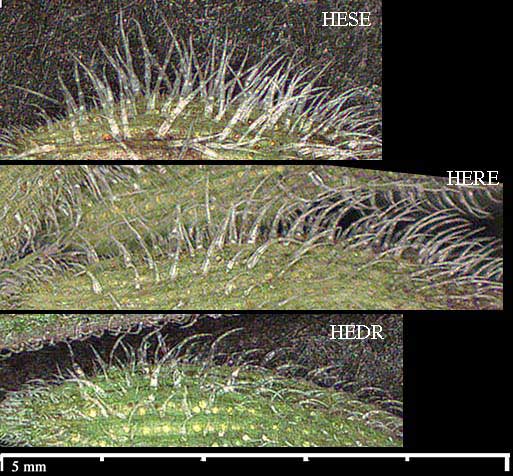
- H. r. s. (HESE):
- Longest hairs are at the mid point and gradually shorter on either side.
- H. r. r. (HERE):
- The longest hairs appear at the mid point and continue long to just below the teeth.
- H. d. (HEDR):
- Longest hairs are restricted to the bottom half, greatly reduced on the upper half.
(3) Trichomes of the teeth
Unless reduced all trichomes of the H. drummondii complex are multicellular, uniseriate. This structure, which plays a critical role in their orientation, is often not clearly discernable without higher magnification with light through the hair, as with a compound microscope; e.g., calyx tube trichomes and tooth trichomes of H.r.s. at 100x shows the septa ('s', cross-walls) separating the cells:
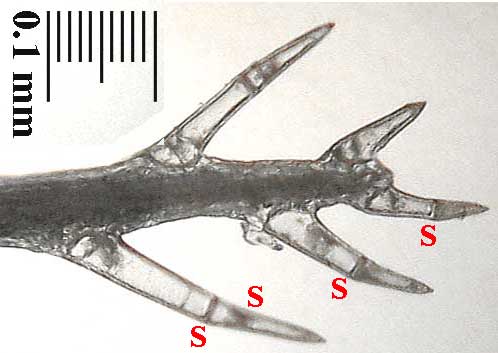 |
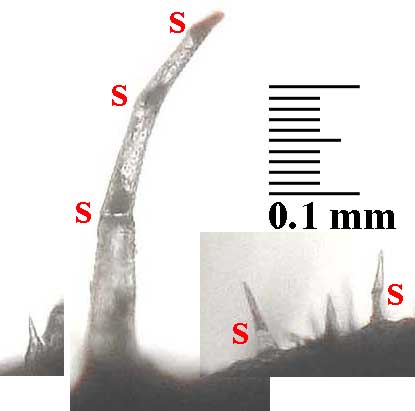 |
| Tip of lower tooth | 3 selections from calyx tube |
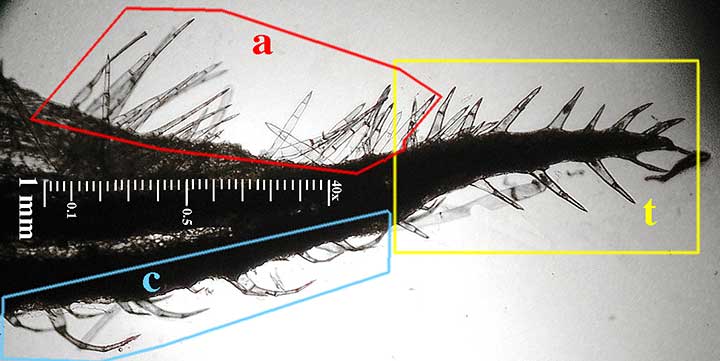
3 types of upper calyx trichomes: t (yellow): upper tooth; a (red): annulus (inner surface), hair angle disturbed by dissecting; c (blue): tube (outer surface) — H.d.; dissected, 40x.
[Click for larger view]
Although teeth also have scattered tiny hairs, the most noticeable trichomes are different from those of the tube. They occur only on the margin at well–spaced intervals; they are stout, subulate from a much wider base, relatively straight from a base cell which is angled upward ca. 35–55°. Cells above the base either continue straight or are slightly angled upward. A few small triangular trichomes may be present, also angled upward.
The teeth trichomes appear to be distinctive:
- H. r. r.:
- The lower teeth trichomes are wider at the base & often shorter than those of the upper teeth, but not longer.
- H. r. s. :
- The lower & upper teeth trichomes are approximately the same in size.
- H. d.:
- The lower teeth trichomes are larger & wider at the base than those of the upper teeth.
[Click to enlarge]
(4) Trichomes of the annulus
Within the calyx tube, just below the teeth is a dense band (annulus) of erect, long, straight, narrow trichomes. The base cell, however, provides a nearly 90 degree upward bend, placing the upper portion of the trichome almost appressed to the inner calyx surface. (In the images below the scale is between the lower (left) and upper teeth.)
[Click to enlarge]
The above images are typical for the calyx annulus of the three taxa, supporting yet another differentia within the H. drummondii complex (click on the thumbnails below for a larger view):
- H. r. r. & H. d.:
- Calyx annulus in two bands, the upper, often appearing to be a different color, approximately as wide as the lower.
- H. r. s. :
- Calyx annulus not consisting of two discernable bands, upper hairs merging with the lower hairs.
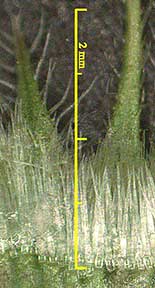
The density and translucence of these hairs makes it difficult to see the individual trichomes, and they tend to break apart at the septa or at the base cell when they are removed for examination.

Annulus hairs of H. r. s. (100x)
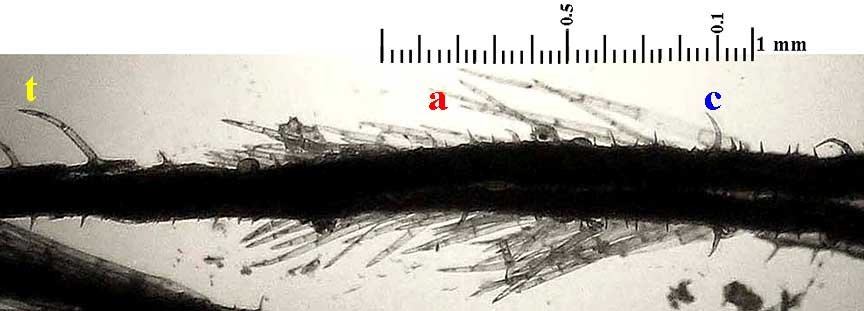
Dissected segment of H. r. s. with teeth hair (t), outer tube hairs (c), and inner cluster of annulus hairs (a) (40x).
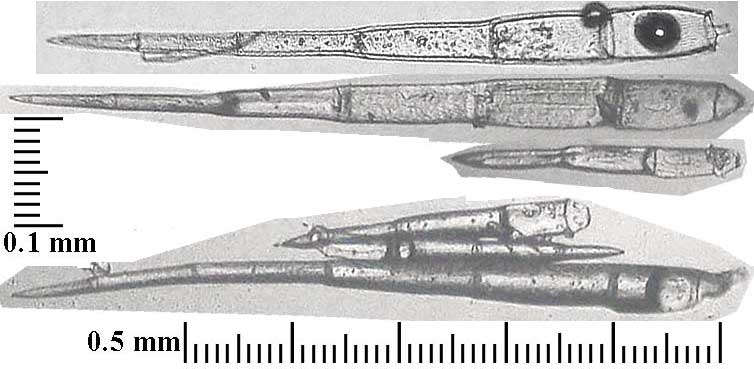
Annulus hairs of H. d. (100x).
Plant Resources Center Home Page — Flora of Texas
— Hedeoma


















